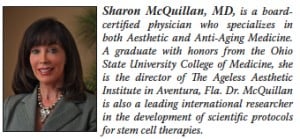In the magical new world of stem cells, one area of great success is facial fat grafting, where the skin takes on a whole new life
WORDS J.P. Faber


Then she met Dr. Sharon McQuillan. “I met her in another doctor’s office, and had a consultation with her about Botox,” says Natasha. “She did it the same day and it was the best treatment of Botox I ever had, so I asked her, ‘What else can you do for my face?’ And that’s when she told me about stem cells.”
Stem cells—the master cells that can take on the characteristics of other cells—are now being used for a whole array of cosmetic and therapeutic applications. Unlike the embryonic stem cells that caused so much controversy during the Bush administration, adult stem cells, derived from a person’s fat, can do just about everything their taboo cousins could do—namely, take on the characteristics of the tissue they are injected into.
“The realization that most of us have adequate fat to harvest, and that it’s such a rich source of stems cells, has opened up new ideas about how to improve patients lives,” says Dr. McQuillan, who has pursued research on stem cell applications for both cosmetic and therapeutic purposes—for everything from damaged heart muscle to cartilage repair. “For cosmetic purposes, we’ve had great success, because of what the stem cells do.”
In the past, fat that was transferred to a patient’s face from another area was rarely fully retained. As much as 50 percent would be lost—or worse, calcified—as the fat died and was reabsorbed. Adding stem cells to the fat dramatically improved retention, because the stem cells ‘vascularize’ the fat, building a network of capillaries to keep it alive. Plus, they actually become new fat cells themselves.
Different stem cell doctors use varying techniques to process stem cells. Many simply take the patient’s fat and place it in a centrifuge. A few thousand revolutions later and the fat separates into layers, with one layer consisting of super-heavy ‘stem cell-enriched’ fat.


What Dr. McQuillan and Comella use is an enzymatic method, whereby the fat is partially digested, the stem cells released, then cleaned, filtered and remixed with the patient’s fat. The result is that you can produce—and count—a huge number of viable stem cells, between 500,000 and 1 million per every cc of fat.
“[Dr. McQuillan] removed fat from in-between my knees, separated the stem cells from the fat cells, put it back with the fat and put it in my face,” says Natasha. “I had it done a year ago. It’s been fantastic; it literally took 10 years off my face and has held up wonderfully… it’s like the facelift for the new millennium.”
Part of the improvement that Natasha experienced had to do with the new facelift trend of rebuilding lost volume in the face, rather than stretching skin, the traditional technique used by plastic surgeons. The other improvements that she experienced had to do with the tendency of stem cells to heal and improve the skin itself.
“The long-term effect on the skin is remarkable,” says Todd Malan, MD, a cosmetic surgeon who uses stem cells in his practice in Scottsdale, Ariz. “There is thickening of the skin, repair of solar damage and repair from aging… we are seeing remarkable healing capacity.”
Dr. McQuillan, who trains other doctors in stem cell techniques and technologies, is also actively involved in research trials for numerous applications that include repairing damaged lungs, knees and hearts and even reversing neurological degenerative diseases. While these procedures are all undergoing various trails to establish scientific protocols, however, in the area of cosmetic improvements the genie is already out of the bag.
“Research demonstrates 35 percent greater volume retention with stem cell augmented fat transfers, as opposed to traditional fat grafting,” says Dr. McQuillan. “But this is just the beginning of what we’ll be able to do. We are going to change the face of medicine.”
In the meantime, she is changing the faces of patients, one happy visage at a time.
“It’s definitely made my life better,” says Natasha. “I feel great, I get complimented all the time, people say my skin glows and tell me that I look much younger than I am. I love it when I get asked for my I.D.”












